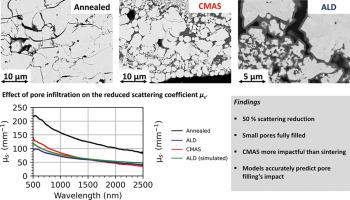Acta Materialia ( IF 8.3 ) Pub Date : 2023-03-07 , DOI: 10.1016/j.actamat.2023.118830 F. Blanchard , M.J. Kadi , E. Bousser , B. Baloukas , M. Azzi , J.E. Klemberg-Sapieha , L. Martinu

|
Thermal barrier coatings (TBCs), which protect metallic components in aircraft engines thanks their low thermal conductivity, must also be effective blockers of radiative heat. While their porous microstructure makes them highly reflective to visible and infrared light through scattering, it also renders them susceptible to degradation, particularly due to calcium-magnesium-alumino-silicate (CMAS) infiltration. This study explores its effect on the optical scattering coefficient of TBC yttria-stabilized zirconia (YSZ) topcoats deposited by atmospheric plasma spray (APS) with two different microstructures. Different CMAS compositions are investigated by isothermal melting into the coatings, resulting in a significant decrease of their reduced scattering coefficients by around 50%. To further study the evolution of their performance as the pores are filled, atomic layer deposition (ALD) is used to mimic CMAS infiltration in a controllable fashion. The results show that most of the performance loss occurs with very little material inserted into the pores and that a saturation point is quickly reached. This is explained by two mechanisms: pores approximately 2 µm in diameter and less are responsible for most of the optical performance and are filled up rapidly, while the refractive index contrast at every pore's interface diminishes when material fills the voids. The obtained minimum scattering coefficient value is approximately half that of a pristine sample and matches with the values obtained by the CMAS melting approach. Finite-difference time-domain (FDTD) modeling is also shown to corroborate the observed saturation behavior and demonstrated to be a suitable tool for the design and optimization of future TBCs.
中文翻译:

CMAS 渗透对热障涂层光学性能的影响:FDTD 模拟和 ALD 支持的机制研究
热障涂层 (TBC) 因其低导热性而保护飞机发动机中的金属部件,它也必须是辐射热的有效阻隔剂。虽然它们的多孔微结构使它们通过散射对可见光和红外光具有高反射性,但也使它们容易降解,特别是由于钙镁铝硅酸盐 (CMAS) 渗透。本研究探讨了其对大气等离子喷涂 (APS) 沉积的具有两种不同微观结构的 TBC 氧化钇稳定氧化锆 (YSZ) 面漆的光学散射系数的影响。通过等温熔化到涂层中来研究不同的 CMAS 组合物,导致其降低的散射系数显着降低约 50%。为了进一步研究它们在孔隙被填充时的性能演变,使用原子层沉积 (ALD) 以可控方式模拟 CMAS 渗透。结果表明,大部分性能损失发生在插入孔隙中的材料很少并且很快达到饱和点时。这可以通过两种机制来解释:直径约 2 µm 或更小的孔隙决定了大部分的光学性能,并且会被迅速填充,而当材料填充空隙时,每个孔隙界面的折射率对比度会降低。获得的最小散射系数值大约是原始样品的一半,与 CMAS 熔化方法获得的值相匹配。











































 京公网安备 11010802027423号
京公网安备 11010802027423号